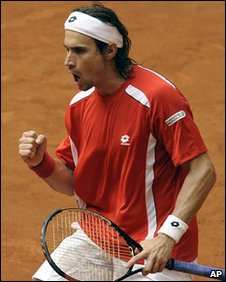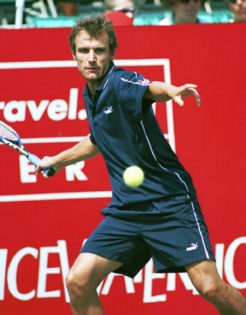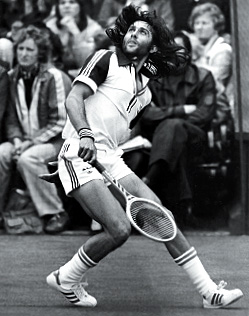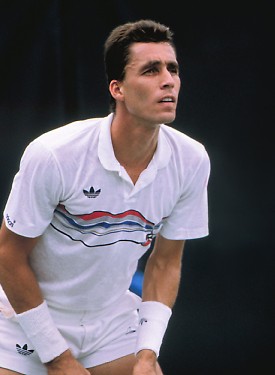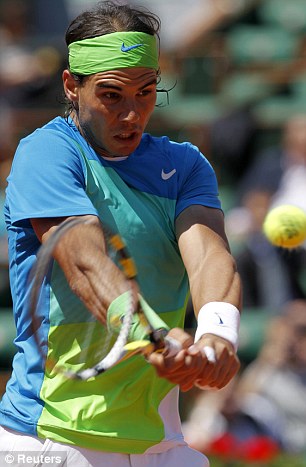Ranking the Most Successful Male Clay Court Players of the Modern Era
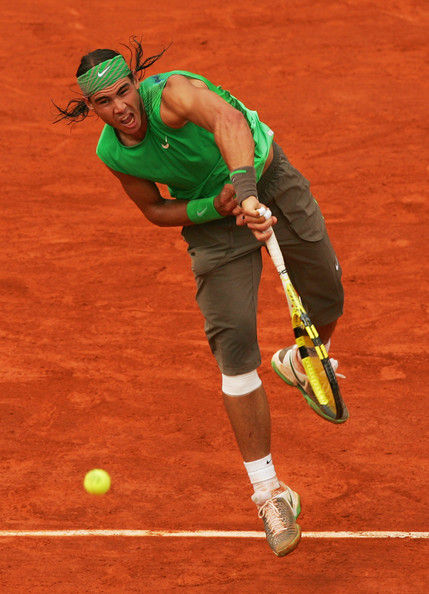 Heading into the French Open, the second major of the season, most players prepare diligently for their final hurrah on clay. It remains as probably the least understood and least appreciated of the court surfaces players endure each year.
Heading into the French Open, the second major of the season, most players prepare diligently for their final hurrah on clay. It remains as probably the least understood and least appreciated of the court surfaces players endure each year.
If the truth be told, players who learn to play on clay and who embrace the surface’s forgiving nature generally become better, more successful all-around players than those who learn the game on grass or hard courts.
The typical clay court player excels in patience by learning how to develop points as well as excellent defensive skills.
For a long time it seemed that some players segregated their careers by either avoiding clay altogether or by playing exclusively on the red dirt. But with the start of the Open Era and the necessity to play on multiple surfaces, some players built successful all-court games using clay court expertise as the foundation.
These male players achieved a top ten ATP ranking, a winning percentage in excess of 70 percent on clay throughout their careers—as well as double digit title wins on clay. Most also won at least one French Open, although not all.
(14) Carlos Moya of Spain
Career clay wins/losses: 337-143. Winning percentage 70.2. Career clay titles: 16.
Carlos Moya won the French Open in 1998 and climbed to the world No. 1 ranking in 1999. Moya became the first Spaniard to hold the No. 1 spot since the ATP began its current ranking system. He held that lofty position only two weeks before Sampras grabbed the top spot back.
Moya turned pro in 1995 and won the first of his 16 clay court titles at Buenos Aires that year defeating Felix Mantilla of Spain. Moya was runner-up twelve times in clay court finals in addition to his 16 victories.
Starting in 2005, Moya fell out of the top ten. A persistent foot injury proved to be too much to allow Moya to return to world class form. He retired from tennis in 2010.
Moya was well-respected by players on tour and was one of the leaders of the Spanish wave that seemed to overwhelm the tour in the 2000s.
(13) David Ferrer of Spain
Career clay wins/losses: 252-102. Winning percentage 71.2. Career clay titles: 10.
At 31 years of age David Ferrer achieved his highest ATP ranking. He currently sits at No. 4, looking over his shoulder as Rafael Nadal continues to climb in 2013.
Ferrer is known for his dogged determination. He never gives up on a point and scrambles to every ball, finding a way to return it. Suffering from no major injuries, Ferrer manages to be very effective on clay, winning one title in 2013 at Buenos Aires, defeating Stanislas Wawrinka in the final.
In addition to that victory on clay, Ferrer has reached the finals in Acapulco, losing to Nadal, and the finals in Oeiras, losing to Wawrinka.
Even at age 31, Ferrer shows no signs of slowing up on clay or any surface, for that matter.
(12) Juan Carlos Ferrero of Spain
Career clay wins/losses: 254-95. Winning percentage 72.8. Career clay titles: 13.
Juan Carlos Ferrero, currently 31 years of age, retired from the tour in October of 2012. He was a right-hander who employed a two-handed backhand with uncanny accuracy.
After losing to Albert Costa in the finals of the 2002 French Open, Ferrero won the 2003 French Open—defeating Martin Verkerk in straight sets in the final. Later in 2003, Ferrero rose to the No. 1 ranking, taking it away from American Andre Agassi at the conclusion of the US Open at Flushing Meadows.
In 2004 injuries began to plague the Spaniard, seeing him drop out of the top 30 in men’s tennis. Although Ferrero remained in the top 30 for most of the next few years, he was never able to climb the rankings ladder back into the top ten.
(11) Yannick Noah of France
Career clay wins/losses: 215-74. Winning percentage 74.4. Career clay titles: 12.
Frenchman Yannick Noah played the most significant part of his career in the 1980s. He won the French Open in 1983, defeating Mats Wilander in the final. Paris sizzled that summer because Noah was the first Frenchman to win at Roland Garros in 37 years. No Frenchman since Noah has managed to win the French Open.
Teamed with partner Henri Leconte, Noah also won the doubles title in Paris in 1984.
Noah reached 19 finals on clay courts, winning 12 of them. In 1986 he climbed to his highest ATP ranking reaching No. 3 in the world.
Noah’s athleticism and his charismatic smile made him very popular throughout the world . He became a great ambassador for tennis, making tennis exciting and fun to watch.
(10) Mats Wilander of Sweden
Career clay wins/losses: 264-80. Winning percentage 76.7. Career clay titles = 20.
In 1982, playing in his first French Open Championship, 17-year-old Mats Wilander became the youngest ever French Open champion. This record would soon be surpassed by American Michael Chang.
By winning at Roland Garros on his first attempt, Wilander set another record which was later equalled by Rafael Nadal in 2005.
Throughout his career, Wilander was a dogged competitor whose ease of movement around the court was deceptive. He employed a two-handed backhand with great efficiency and effectiveness.
Wilander won 20 titles on clay including three French Open Championships in 1982, 1985 and 1988. He achieved the No. 1 ranking in 1988 after winning three of four Grand Slam titles. He also reached two French Open finals in 1983 and 1987, losing to Yannick Noah and Ivan Lendl respectively.
Wilander remained dedicated to Davis Cup tennis throughout his career and into retirement where he served as coach for Sweden. Wilander’s patience on court and his ability to construct points were direct results of his skill in clay court tennis.
(9) Roger Federer of Switzerland
Career clay wins/losses: 179-54. Winning percentage 76.8. Career clay titles = 10.
Roger Federer is, of course, still active. In fact playing on clay at the moment in Rome as the tour makes its last stop before Paris in 2013. The fact that the Swiss is on this list of best clay court players may seem remarkable to casual observers of the game.
But for many years throughout his career Federer was (and still may be) the No. 2 player on the surface. Unfortunately for Federer, he generally met Rafael Nadal in finals on clay courts. The Swiss seldom won those contests.
He met Nadal consecutively in French Open finals from 2006-2008, losing to him each time. In 2009 Federer finally won his first, and to date only, French Open title defeating Robin Soderling in the final. Soderling had upset Nadal in the fourth round in a stunning turn of events. In all Federer has reached five French Open finals in his career, losing to Nadal four times.
Federer, of course, was ranked world No. 1 for 302 weeks and is currently ranked No. 3 heading into Paris. So far in 2013, Federer remains winless.
(8) Manuel Orantes of Spain
Career clay wins/loses: 489-147. Winning percentage 76.9. Career clay titles = 29.
Spaniard Manuel Orantes played primarily in the 1970s and 1980s. In 1975 he won the US Open played at Forest Hills on clay. He defeated Jimmy Connors in the final. Orantes also reached the finals of the French Open in 1974, but lost in five sets to Bjorn Borg after running out to a 2-0 lead.
Orantes was a left-hander with a deft one-handed backhand. He was a commanding presence on court, yet remained one of the friendliest players on tour. His crowning achievement was in Davis Cup play where he participated eagerly for several years.
Orantes won 29 singles titles on clay and achieved a career high ranking of world No. 2 in 1973—remaining in the top ten in rankings for five straight years. He also won 17 doubles titles on clay.
He remains one of the great Spanish clay court players of the Open era.
(7) Thomas Muster of Austria
Career clay wins/losses: 422-127. Winning percentage 76.9. Career clay titles = 40.
Thomas Muster came to prominence during the 1990s when he became known as the “King of Clay” to his fans and the media. He climbed to the No. 1 ranking in February of 1996.
He won the French Open in 1995, defeating Michael Chang in the final. But that was the only men’s final he reached on the grounds of Stade Roland Garros. Throughout his career Muster won 40 singles titles on clay, a feat Rafael Nadal just equalled when he won the title in Madrid in 2013. His record in clay court finals was 40-5. This included Masters Series titles on clay where Muster won at Rome and Monte Carlo three times each.
A knee injury in 1989 made competition on any other surface than clay almost impossible for Muster. But he became almost unbeatable on that surface throughout his career. He did enjoy some success on hard courts, but never grass.
After a brief attempted comeback in 2010-2011, Muster is now firmly retired from men’s professional tennis.
(6) Jose-Luis Clerc of Argentina
Career clay wins/losses: 301-88. Winning percentage 77.4. Career clay titles = 21.
Jose-Luis Clerc was a contemporary of the great Guillermo Vilas, both playing tennis for Argentina—although Clerc was six-years Vilas’ junior. Most of Clerc’s major accomplishments on the tennis court came during the 1980s.
Clerc reached his highest ranking in August of 1981 when he climbed to the No. 4 spot in the ATP. He played right-handed, utilizing a one-handed backhand. His best, favored surface was clay where he achieved an outstanding winning percentage of 77.4.
Throughout his career Clerc won 25 career singles titles, 21 of them on clay. The Argentine never won the French Open Championship. His furthest advancement was the semifinals in 1981 and 1982.
(5) Ilie Nastase of Romania
Career clay wins/losses: 315-91. Winning percentage 77.6. Career clay titles = 27.
Ilie Nastase played his most successful tennis during the 1970s. He achieved the No. 1 ranking in August of 1973. Throughout his career Nastase won more than 100 pro titles, in singles and doubles. Of his 57 career singles titles, he won 27 of them on clay.
He won the French Open title in 1973, defeating Nikola Pilic of Yugoslavia in straight sets. Nastase was the runner-up at Stade Roland Garros in 1971, losing to Jan Kodes in four sets.
He won the French Open in doubles in 1970, teamed with Ion Tiriac.
Most players and fans remember Nastase as a character whose antics on court often sent officials scrambling. The Romanian loved to entertain, regardless the situation.
Additionally, the man was very talented and certainly added to rich legacy of clay court tennis.
(4) Guillermo Vilas of Argentina
Career clay wins/losses: 639-163. Winning percentage 79.7. Career clay titles = 46.
Argentine Guillermo Vilas won the French Open in 1977, defeating Brian Gottfried in the final. He also advanced to additional French Open championship matches, losing to Bjorn Borg in 1975 and 1978 and again in 1982, losing to Mats Wilander. Vilas also won the US Open in 1977, played on clay at Flushing Meadows where he defeated Jimmy Connors in the final.
Throughout his career, Vilas won an astonishing 639 matches on clay, giving him a winning percentage of 79.7.
Vilas was a left-handed baseline player who used a one-handed back hand. Officially, his highest ranking was world No. 2 which he achieved on April 30, 1975, although some believe Vilas and Borg should have rightfully shared the No. 1 ranking in 1975.
Vilas retired from professional tennis in 1992.
(3) Ivan Lendl of Czechoslovakia
Career clay wins/losses: 329-75. Winning percentage 81.4. Career clay titles = 28.
Ivan Lendl dominated tennis in the 1980s when he held the No. 1 ranking for the greater part of five years. His first No. 1 ranking came in February of 1983 but Lendl would not win his first major until the French Open in 1984 when he defeated John McEnroe. The American held a 2-0 lead in the match before Lendl came back to win in five.
Lendl would go on to win two more titles at Roland Garros in 1986 and 1987. The Czech was runner-up twice in 1981 and 1985.
Lendl played baseline power tennis employing heavy topspin while many of the top players preferred to serve and volley on all surfaces. He led the way in fitness and attention to detail in all aspects of his game. He has been called the “father” of modern power tennis.
He exceled on clay and on hard courts but had little success on Wimbledon grass, despite all his efforts to win that elusive major. With over a winning percentage over 80, Lendl remains one of the best ever to play tennis on clay.
(2) Bjorn Borg of Sweden
Career clay wins/losses: 245-39. Winning percentage 86.3. Career clay titles = 30.
For many years Bjorn Borg was the standard-bearer when it came to clay court tennis for men. No one could come close to equaling his winning percentage or his six French Open Championships.
He achieved the No. 1 ranking for the first time in 1977.
Like Nadal, Borg was seldom defeated at the French Open—twice to the same man Adriano Panatta in 1973 and 1976—otherwise the great Borg remained undefeated. He owned Paris during the time the French Open was being played.
In 1974 Borg won the tournament for the first time when he was 18 years of age, the youngest male ever until Mats Wilander erased that record in 1982. By then Borg was no longer playing the game.
Borg was a right-hander, using a two-handed backhand. Primarily a baseline player, Borg had deceptive speed which allowed him time to employ topspin on both his backhand and forehand strokes The powerful Swede developed uncanny accuracy in placing the ball. On clay he was impossible to beat, according to many of his contemporaries.
He left the game at age 26. Perhaps, he could have increased his records on clay—but we will never know. The records he amassed on clay, however, remain a testament to his greatness on this surface.
(1) Rafael Nadal of Spain
Career clay wins/losses: 280-21. Winning percentage 93.0. Career clay titles = 40.
No man exemplifies clay court tennis more than Rafael Nadal. He is a natural on the surface and often renders his opponents impotent as they try to defeat him on the red dirt.
He has won the French Open a record-setting seven times, winning in Paris in 2005 on his first try. He has lost on the grounds of Stade Roland Garros only once—to Robin Soderling in 2009 during the fourth round. It was a stunning upset. But one loss in eight grand slam tournaments is a remarkable record.
In addition to his French Open record, however, Nadal also owns the record for the most wins at any single tournament—the clay courts of Monte Carlo where he’s won eight consecutive titles. He also holds the record at Rome with six titles and Barcelona with eight.
Nadal achieved the No. 1 ranking for the first time in August of 2008, finally wrestling it away from Roger Federer. Nadal had occupied the No. 2 spot since 2005.
Injuries have subsequently forced the Spaniard to relinquish that top spot, often sidelined for months at a time while his knees healed. Today he is ranked No. 5 but playing extremely well on the clay courts again.
Like Borg, Nadal employs heavy topspin on both his forehand and backhand. But he has upped the spin on his strokes to a new level in men’s tennis. With aggressive court coverage using his speed and dexterity, Nadal can switch from defense to offense in the blink of eye.
The question remains, however, as to how long Nadal’s knees will allow him to play. The clay courts are forgiving but synthetic surfaces are to jarring for Nadal’s style of play. Currently, he is going strong, heading for another French Open Championship.
Without a doubt, Nadal is the greatest man ever to play tennis on clay courts.
